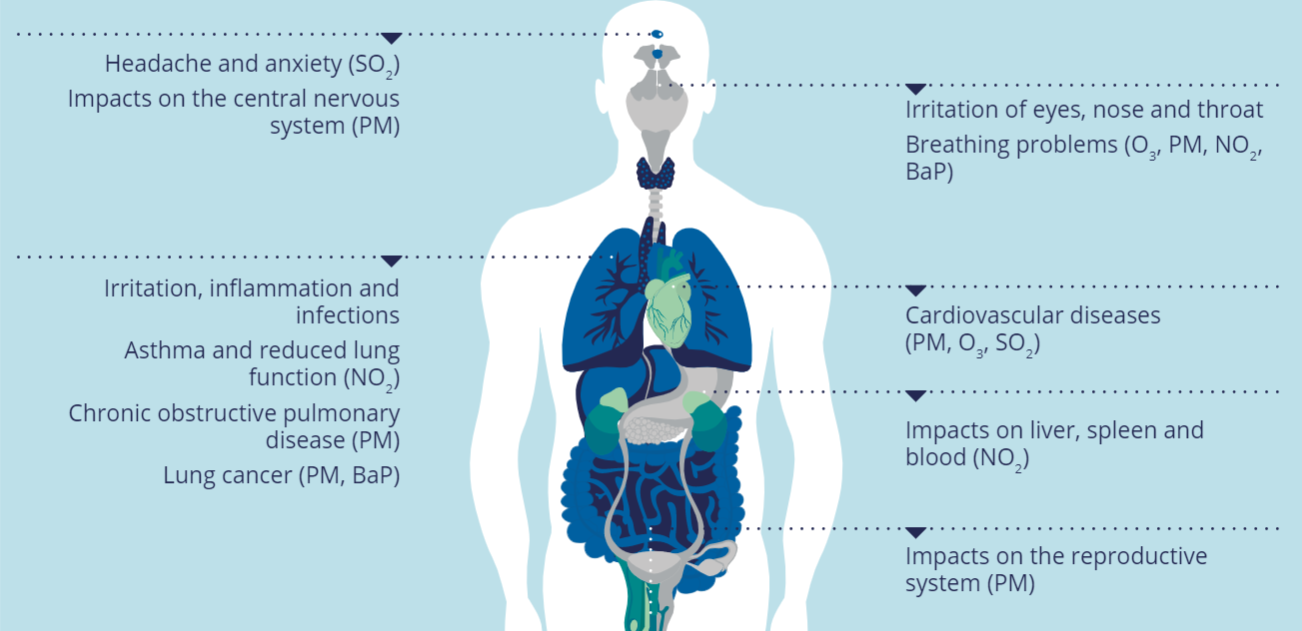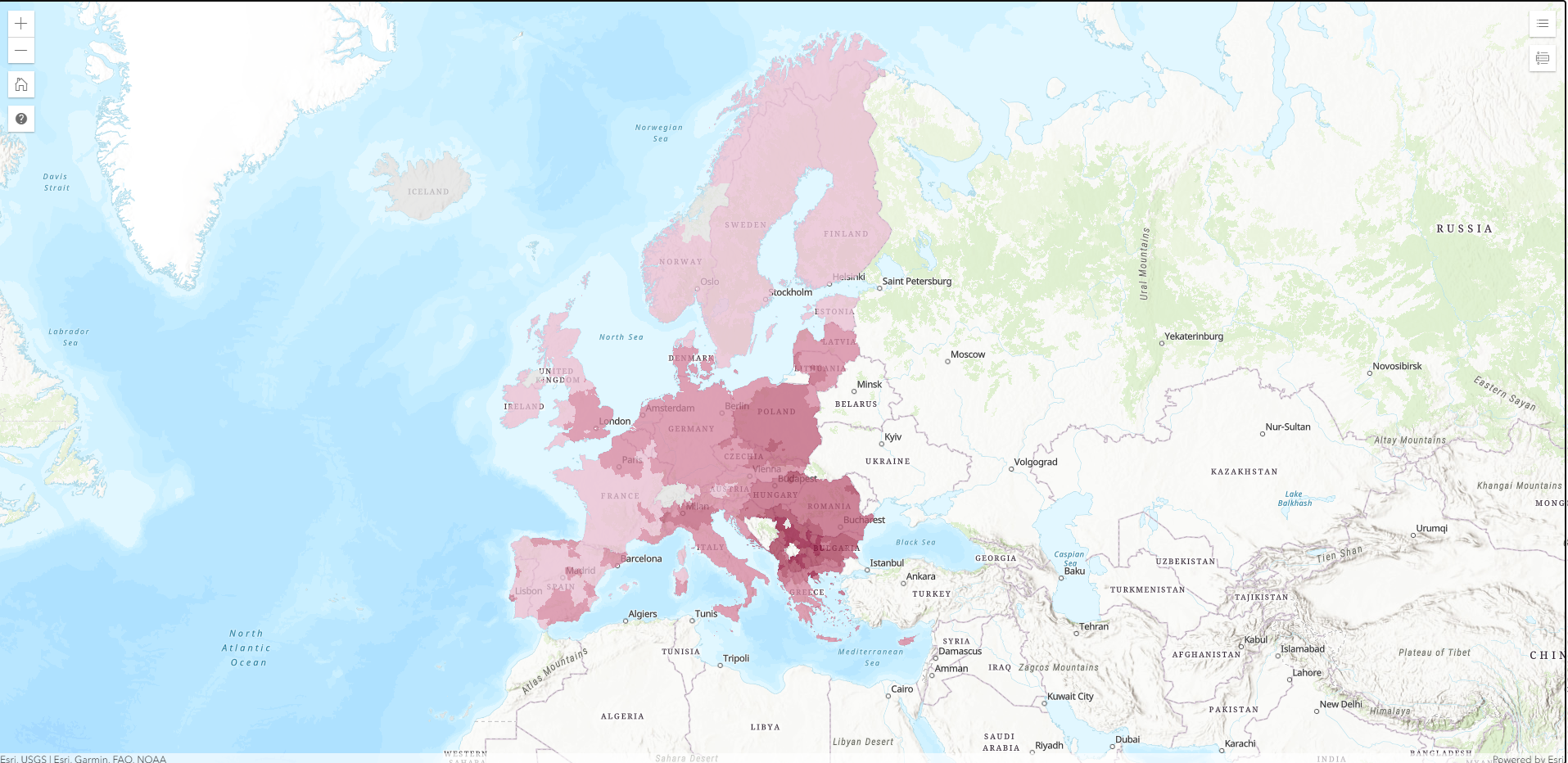Most Europeans live in areas, especially cities, where air pollution can reach high levels. Both short- and long-term exposure to air pollution can lead to a wide range of diseases, including stroke, chronic obstructive pulmonary disease, trachea, bronchus and lung cancers, aggravated asthma and lower respiratory infections. The World Health Organization (WHO) provides evidence of links between exposure to air pollution and type 2 diabetes, obesity, systemic inflammation, Alzheimer’s disease and dementia. The International Agency for Research on Cancer has classified air pollution, in particular PM2.5, as a leading cause of cancer. A recent global review found that chronic exposure can affect every organ in the body, complicating and exacerbating existing health conditions.

Note: Particulate matter with a diameter of 2.5 µm or less (PM2.5), particulate matter with a diameter of 10 µm or less (PM10), ozone (O3), nitrogen dioxide (NO2), benzo[a]pyrene (BaP) and sulphur dioxide (SO2).
Source: EEA, "Healthy environment, healthy lives ," 2019
Fine particulate matter (PM2.5) is the air pollutant driving the most significant health problems and premature mortality. In 2019, PM concentrations exceeded EU limit values in large parts of Europe.
due to fine particulate matter
The EEA estimates that, in 2019, approximately 307,000 premature deaths were attributable to PM2.5 in the 27 EU Member States. Nitrogen dioxide (NO2) was linked to 40,400 premature deaths, and ground-level ozone was linked to 16,800 premature deaths.
In 2021, the World Health Organization (WHO) published new air quality guidelines to protect human health, updating the 2005 air quality guidelines on the basis of a systematic review of the latest scientific evidence of how air pollution damages human health.
The European Union (EU) also set standards for key air pollutants in the ambient air quality directives. Although these values were based on the 2005 WHO air quality guidelines, they also reflect the technical and economic feasibility of their attainment across EU Member States. The EU air quality standards are therefore less demanding than the WHO air quality guidelines.
Under the European Green Deal’s Zero Pollution Action Plan, the European Commission set the 2030 goal of reducing the number of premature deaths caused by PM2.5 by at least 55% compared with 2005 levels. To this end, the European Commission initiated a revision of the ambient air quality directives, aiming to align the air quality standards more closely with WHO recommendations.
In terms of the past trend, from 2005 to 2019 premature deaths attributed to PM2.5 exposure in the EU 27 fell by 33% to reach 307,000. Should air quality continue to improve, and the number of premature deaths per year continue to fall at a comparable rate in the future, then the Zero Pollution target would be achieved by 2032, as shown in the figure below.
Premature deaths attributed to PM2.5 in the EU-27 from 2005-2019, and distance to the target of a 55% reduction in the 2005 levels of premature deaths
Inequalities in exposure and vulnerability to air pollution in Europe
Air pollution affects people in different ways. Older people, children and those with pre-existing health conditions are more sensitive to the health impacts of air pollution. In addition, the most deprived people in society often have poorer health and less access to high-quality medical care, increasing their vulnerability.
There is strong evidence linking lower socio-economic status to increased exposure to air pollution. In large parts of Europe, poorer people are more likely to live next to busy roads or industrial areas and thus, face higher levels of exposure to air pollution. At the same time, exposure patterns vary across European cities. In some cities, wealthier people live in central, polluted areas, while in other European cities central areas are inhabited by poorer communities.
In Europe, regions characterised by lower GDP per capita are found to have higher levels of PM2.5 and tend to occur in Eastern and South-eastern Europe. This pattern is largely driven by the combustion of low-quality solid fuels (e.g. coal and wood) in low-efficiency ovens for domestic heating in those areas. The higher population exposure to PM2.5 in particular regions, translates into higher numbers of premature deaths attributed to air pollution.
Mapping mortality attributed to PM2.5 against regional wealth in Europe
The interactive map viewer shows the spatial distribution of population-weighted concentrations of PM2.5 (as an indication of population exposure) across Europe and the associated mortality. The viewer also allows to display data against GDP per capita as a proxy for the average socio-economic characteristics of the population in each region. The data is presented for NUTS3 regions (between 150 000 and 800 000 inhabitants).

GDP per capita - Eurostat; Premature deaths, years of life lost and population-weighted concentrations are based on an EEA analysis of interpolated annual statistics of reported monitoring data from 2018 (see Map 9.1 in EEA, 2020) and the Geostat 2011 population grid data set.
Further information:
How is the COVID-19 pandemic linked to air pollution?
The temporary reduction in human activities resulted in lower emissions of some air pollutants. Air quality data reported to the EEA shows that concentrations of nitrogen dioxide (NO2) — a pollutant mainly emitted by road transport —decreased in April 2020 in many European cities, where lockdown measures had been implemented (with large variations among and within cities), relative to business-as-usual scenario. The largest fall in NO2 concentrations (around 70 %) was seen at traffic air monitoring stations in Spain and Italy. The ongoing fluctuations in NO2 concentrations can be found in our data viewer and in the recent EEA article on COVID-19 and the environment.
PM10 concentrations also tended to be lower in April 2020 compared to business-as-usual scenario. The greatest relative reductions (35 – 40 %) were estimated at traffic stations in Spain and Italy, whilst limited number of sites (mainly rural background stations) recorded increase in PM10 concentrations. The smaller reduction in PM10 concentrations compared to NO2 is due to the PM concentrations being influenced by both primary emissions from anthropogenic and natural sources and by precursor gases emitted from different sources, which can subsequently form PM in the atmosphere.
There are two other relationships between air pollution and COVID-19: the possible effect of air pollution on vulnerability and susceptibility to COVID-19 (via previous long-term exposure to air pollutants), and the possible role of air pollution in spreading the SARS-CoV-2 coronavirus. Some very recent studies, some produced in the early days of the COVID-19 pandemic, have explored those links but they need to be interpreted with care and further research is needed.
Cover image: © Jean-Jacques Poirault, ImaginAIR /EEA
Document Actions
Share with others